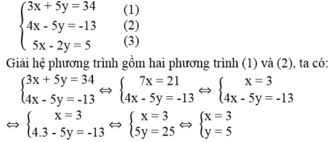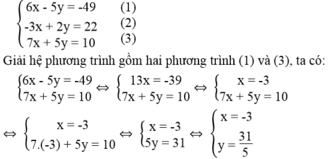
Hãy nhập câu hỏi của bạn vào đây, nếu là tài khoản VIP, bạn sẽ được ưu tiên trả lời.



Thay x = 3, y = 5 vào vế trái của phương trình (3) ta được:
VT = 5.3 – 2.5 = 15 – 10 = 5 = VP
Vậy (x; y) = (3; 5) là nghiệm của phương trình (3).
Hệ phương trình đã cho có nghiệm (x; ) = (3; 5)

a: Khi m=2 thì pt sẽ là x^2-6x-3=0
=>\(x=3\pm2\sqrt{3}\)


Thay x = -3, y = 31/5 vào vế trái của phương trình (2), ta được:
VT = -3.(-3) + 2.31/5 = 9 + 62/5 = 107/5 ≠ 22 = VP
Vậy (x; y) = (-3; 31/5 ) không phải là nghiệm của phương trình (2).
Hệ phương trình đã cho vô nghiệm.

\(x^2-\left(2-\sqrt{3}\right)x-2\sqrt{3}=0\)
\(\Delta=\left[-\left(2-\sqrt{3}\right)^2\right]-4\left(-2\sqrt{3}\right)\)
\(=\left(4-4\sqrt{3}+3\right)+8\sqrt{3}=7+4\sqrt{3}=\sqrt{3}^2+2.2.\sqrt{3}+2^2=\left(\sqrt{3}+2\right)^2>0\)
=> pt có 2 nghiệm phân biệt
\(\left\{{}\begin{matrix}x_1=\dfrac{2-\sqrt{3}-\sqrt{3}-2}{2}=\dfrac{-2\sqrt{3}}{2}=-\sqrt{3}\\x_2=\dfrac{2-\sqrt{3}+\sqrt{3}+2}{2}=\dfrac{4}{2}=2\end{matrix}\right.\)

a: x^2-mx+m-1=0
Khi m=5 thì (1) sẽ là x^2-5x+4=0
=>x=1 hoặc x=4
b:Δ=(-m)^2-4(m-1)=m^2-4m+4=(m-2)^2
Để phươg trình có 2 nghiệm phân biệt thì m-2<>0
=>m<>2
x2=2x1
x2+x1=m
=>3x1=m và x2=2x1
=>x1=m/3 và x2=2/3m
x1*x2=m-1
=>2/9m^2-m+1=0
=>2m^2-9m+9=0
=>2m^2-3m-6m+9=0
=>(2m-3)(m-3)=0
=>m=3 hoặc m=3/2

Ta có: ∆ = b 2 – 4ac = 1 2 – 4.2.(-3) = 1 + 24 = 25 > 0
∆ = 25 = 5
Phương trình có 2 nghiệm phân biệt :


\(a,\left\{{}\begin{matrix}x+y=3\\2x-3y=1\end{matrix}\right.\\ \Leftrightarrow\left\{{}\begin{matrix}2x+2y=6\\2x-3y=1\end{matrix}\right.\\ \Leftrightarrow\left\{{}\begin{matrix}5y=5\\2x-3y=1\end{matrix}\right.\\ \Leftrightarrow\left\{{}\begin{matrix}y=1\\2x-3.1=1\end{matrix}\right.\\ \Leftrightarrow\left\{{}\begin{matrix}x=2\\y=1\end{matrix}\right.\)
Vậy \(\left(x;y\right)=\left(2;1\right)\)
b, \(x^2-7x+10=0\\ \Leftrightarrow x^2-5x-2x+10=0\\ \Leftrightarrow x\left(x-5\right)-2\left(x-5\right)=0\\ \Leftrightarrow\left(x-2\right)\left(x-5\right)=0\\ \Leftrightarrow\left[{}\begin{matrix}x-2=0\\x-5=0\end{matrix}\right.\\ \Leftrightarrow\left[{}\begin{matrix}x=2\\x=5\end{matrix}\right.\)
\(a,\)\(\left\{{}\begin{matrix}x+y=3\\2x-3y=1\end{matrix}\right.\)
\(\Leftrightarrow\left\{{}\begin{matrix}3x+3y=9\\2x-3y=1\end{matrix}\right.\)
\(\Leftrightarrow\left\{{}\begin{matrix}5x=10\\2x-3y=1\end{matrix}\right.\)
\(\Leftrightarrow\left\{{}\begin{matrix}x=2\\2.2-3y=1\end{matrix}\right.\)
\(\Leftrightarrow\left\{{}\begin{matrix}x=2\\y=1\end{matrix}\right.\)
Vậy hệ pt có nghiệm duy nhất \(\left(x;y\right)=\left(2;1\right)\)
\(b,x^2-7x+10=0\)
\(\Delta=b^2-4ac=\left(-7\right)^2-4.10=9>0\)
\(\Rightarrow\) Pt có 2 nghiệm \(x_1,x_2\)
Ta có :
\(\left\{{}\begin{matrix}x_1=\dfrac{-b+\sqrt{\Delta}}{2a}=\dfrac{7+3}{2}=5\\x_2=\dfrac{-b-\sqrt{\Delta}}{2a}=\dfrac{7-3}{2}=2\end{matrix}\right.\)
Vậy \(S=\left\{5;2\right\}\)





a) X= 1; x=0
b)x=0
x=-3